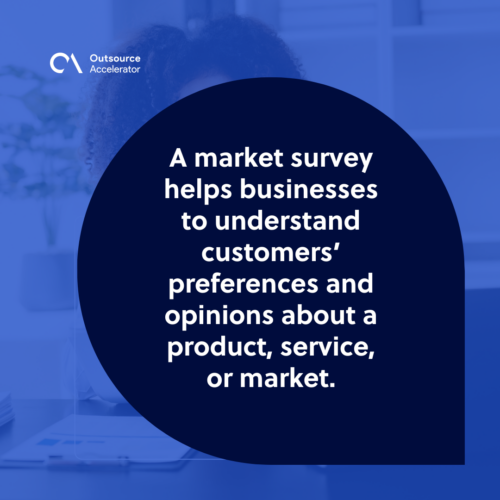Introducing market survey for excellent customer insights

Understanding customers’ needs and preferences enables businesses to develop unique offerings that meet or exceed customer expectations. This can give a competitive edge, and help enterprises attract and retain customers.
Enterprises that consistently deliver products and services aligned with customer’s needs and preferences foster a sense of loyalty.
Keep in mind that loyal consumers are likelier to continue patronizing the business and later become advocates.
Market survey plays a huge part in achieving a wider audience and devoted patrons to your brand. It is a powerful tool enabling your business to gather valuable data from your target market.
But what exactly is a market survey? Read on to learn more about its types, benefits, limitations, and how to design an effective one for your business.
Definition of market survey and its purpose
A market survey is a research method to gather information and insights from a specific target audience. It helps businesses to understand customers’ preferences and opinions about a product, service, or market.
An effective market survey can improve the brand identity of goods or services by bringing into the market tailored services according to clients’ needs.

4 types of market survey
Let’s explore the four main market survey types and understand each method’s benefits and limitations.
1. Virtual survey
A virtual or online survey is a market survey conducted through digital platforms or web-based tools. In a virtual survey, participants are presented with a series of questions that they can answer through online forms or survey platforms.
This approach offers convenience and scalability, allowing businesses to reach a large audience quickly and cost-effectively.
Virtual surveys can be designed to collect quantitative data, such as ratings and rankings, and qualitative data through open-ended questions and comments.
Benefits and limitations
The benefits of virtual surveys include:
- Wide reach – Virtual surveys can be distributed to many participants regardless of their geographical location.
- Convenience – Participants can complete the survey conveniently, reducing non-response chances.
- Cost-effective – Virtual surveys eliminate the need for printing and mailing, making them a cost-effective option.
However, virtual surveys also have limitations, such as:
- Self-selection bias – Participants may have a particular interest or bias towards the topic, leading to potentially skewed results.
- Lack of personal interaction – Virtual surveys lack the human touch of in-person or phone interviews, limiting the ability to probe deeper into participants’ responses.
2. Phone interviews
As the name suggests, phone interviews involve conducting a market survey by speaking with participants over the phone. A trained interviewer contacts participants in a phone interview and asks pre-determined questions.
The data collection strategy provides a more interactive and personal approach than virtual surveys, allowing interviewers to probe further and clarify responses in real-time.
This method is especially useful for collecting detailed qualitative data and gaining deeper insights into participants’ thoughts, experiences, and emotions.
Benefits and limitations
The benefits of phone interviews include:
- Personal interaction – Phone interviews allow for a more engaging conversation, enabling researchers to gather more detailed information.
- Flexibility – Phone interviews can be conducted conveniently for both the researcher and the participant.
Despite its advantages, phone interviews also have limitations:
- Limited reach – Phone interviews are limited to participants who have access to a phone and are willing to engage in a phone conversation.
- Time-consuming – Interviews over the phone can be time-consuming for both the researcher and the participant, which may lead to lower response rates.
3. In-person interviews
In-person interviews involve face-to-face interviews with participants in a physical setting, typically a predetermined location.
A trained interviewer engages in a structured or semi-structured discussion with participants in this market survey method. The surveyor asks questions and records the participant’s responses.
Benefits and limitations
The benefits of in-person interviews include:
- Rich qualitative data – In-person interviews provide researchers with rich qualitative data, allowing for a deeper understanding of participants’ perspectives.
- Non-verbal cues – This market survey allows researchers to observe participants’ non-verbal cues, which can provide valuable insights.
- Trust building – In-person interviews help establish trust and rapport, leading to more honest and detailed responses.
An in-person interview also has its limitations:
- Time and resource-intensive – In-person interviews require more time and resources compared to other survey methods.
- Limited sample size – This market survey type is limited to a smaller sample size due to logistical constraints.
4. Focus groups discussion
A focus group discussion is a qualitative market survey method that involves bringing together a small group of individuals. This is to discuss specific topics or issues relevant to the business’s objectives.
A trained moderator facilitates the discussion, encouraging participants to share their opinions, ideas, and experiences.
Focus groups provide a dynamic environment that encourages participants to build on each other’s responses and generate new insights.
Benefits and limitations
The benefits of focus group discussions include:
- Synergy of ideas – This market survey lets participants to build upon each other’s ideas, leading to more comprehensive insights.
- Group dynamics – Focus groups allow observing group dynamics and how participants influence each other’s opinions.
- Real-time feedback – This market research enables researchers to receive real-time feedback and clarification for better understanding.
Meanwhile, here are the limitations of focus group discussions:
- Dominant participants – Some participants may dominate the discussion, limiting the input from other participants.
- Social desirability bias – Participants may provide socially desirable responses influenced by the group dynamics.

Designing an effective market survey
Several key steps should be followed to design an effective market survey:
Define research objectives
Clearly defining the research objectives is crucial for conducting an effective market survey.
For instance, if a business wants to launch a new product, it might conduct a market survey to gather customer feedback on its design, features, and price point.
By defining the research objectives, market surveyors can create survey questions in such a way as to address these specific goals:
- Improvement of services
- Enhancement of product offerings
- Streamlining communication channels
Identify target audience
Identifying the target audience of the market survey is an integral part of good survey design.
For example, if a company wants to launch a new athletic shoe, it might interview athletes in its target demographic to gather data based on the athlete’s preferences.
Understanding the target audience can help businesses ensure their survey is efficient and unbiased, as well as ensure they are gathering insights from the right demographic.
Craft relevant and unbiased questions
Crafting relevant and unbiased market survey questions helps enterprises gather high-quality data.
For instance, if they seek to understand customer satisfaction with a specific product, they might ask simple, open-ended questions like “What did you dislike about this product?”
Note that the questions should be crafted neutrally to elicit honest participant responses—free of any loaded or biased terminology.
Structure the survey flow
The market survey should have a logical and intuitive flow structure for participants. For example, the survey might start with general questions about a product or service before diving into more specific queries.
Incorporate demographic questions
Including demographic questions in a market survey helps businesses to slice and dice their data in more specific ways.
For instance, a business might add a question about age, income, or education level that might impact the insights gained in the survey.
Demographic questions help businesses gain insights into varied cohorts and identify group differences.
Remember, the main purpose of conducting a market survey is to obtain accurate and reliable information directly from the target market rather than relying on assumptions.







 Independent
Independent




